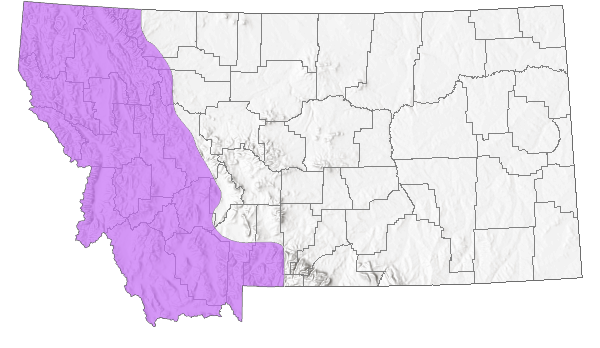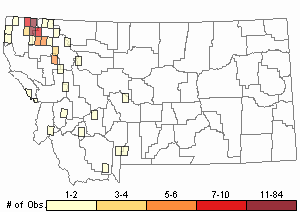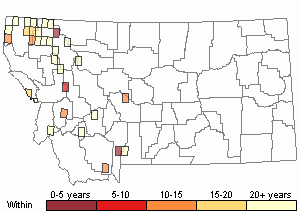View in other NatureServe Network Field Guides
NatureServe
Montana
Utah
Wyoming
Idaho
Wisconsin
British Columbia
South Carolina
Yukon
California
New York
Kidney-leaf White Violet - Viola renifolia
Native Species
Global Rank:
G5
State Rank:
S4
(see State Rank Reason below)
C-value:
8
Agency Status
USFWS:
USFS:
BLM:
External Links
State Rank Reason (see State Rank above)
Viola renifolia occurs in western Montana where it can be common in the understory of wet alder thickets, spruce forests, and wet peat habitats. It has been listed as a Sensitive species by the U.S. Forest Service in Region 1, but surveys conducted in the 1990s to early 2000s demonstrated that populations are widespread, often large (50-1,000 individuals), and stable. Populations growing in wet peat are in a fragile habitat type. Observations that bring forth data on population sizes, habitat conditions, and threats will help continue efforts to track its status and trend in Montana.
- Details on Status Ranking and Review
Population Size
ScoreE - 2,500 - 10,000 individuals
CommentThe 161 observations have an estimate count from 4,561 to about 6,000 plants.
Range Extent
ScoreF - 20,000-200,000 sq km (~8,000-80,000 sq mi)
Comment85,300 square kilometers.
Area of Occupancy
ScoreE - 26-125 4-km2 grid cells
CommentMontana can be divided into 30,390 4x4 square kilometer cells. For this species plant observations occur in 74 of these 4x4 square kilometer cells.
Number of Populations
ScoreD - 81 - 300
Comment161 observations.
Number of Occurrences or Percent Area with Good Viability / Ecological Integrity
ScoreE - Many (41-125) occurrences with excellent or good viability or ecological integrity
Comment51 observations assumed to be of good viability based on descriptors of 'common', 'locally common', and counts from '50-1,000' plants.
Environmental Specificity
ScoreC - Moderate. Generalist or community with some key requirements scarce
Threats
ScoreD - Low
CommentHabitat is wet peat which is fragile. Wet peat in forested habitat could be subjected to forestry prescriptions.
General Description
PLANTS: Perennial herbs that lack a central stem (acaulescent) where the flower peduncle and the leaf petiole grow directly from a thick, fleshy rhizome. Plants are sparsely pubescent and 5-30 cm tall. Sources: Lesica et al. 2012; Little in Flora of North America [FNA] 2015.
LEAVES: Basal, 1-5 in number, with petioles, and prostrate to ascending. Petioles are 3-10 cm and hairy (pubescent). Blades are simple (not lobed), reniform (broader than long) with crenulate margins, 2-6 cm wide. Surfaces are sparsely to densely pubescent. Stipules are lanceolate. Sources: Lesica et al. 2012; Little in FNA 2015.
INFLORESCENCE: A single, white flower that is scapose and arises from a rhizome. Peduncles are 5-8 cm long, puberulent. Flowers are 10-15 mm long. Sepals are 5 in number, separate, usually not ciliate, and lanceolate to ovate in shape with 1-2 mm long auricles. Petals are 5 in number, separate, beardless, and white. The upper 2 petals are erect. The lower 3 petals spread and are purple-veined; lowest petal is 8-10 mm. The sac-like spur is colored the same as the petals, swollen on one side (gibbous), and 1-2 mm long. Fruit is a capsule. Sources: Lesica et al. 2012; Little in FNA 2015.
Viola is the Latin name for the plant, derived from the Greek word ion for 'violet' (Little in FNA 2015; Giblin et al. [eds.] 2018).
Phenology
Flowering from June to July in Montana; across its range from April through June (Little in FNA 2015).
Diagnostic Characteristics
Viola species exhibit great phenotypic variation. Leaf and stem sizes usually increase a lot between early spring and late summer (Little in FNA 2015). Stem, leaf, and flower sizes vary with environmental factors, such as aspect, light, soil moisture, and other soil properties (Little in FNA 2015).
Montana has about 3 Viola species that lack central stems (acaulescent), have simple leaf blades, and have whitish flowers:
Kidney-leaf White Violet - Viola renifolia
*Petioles-Peduncles: Peduncles are shorter than the leaves (petiole and blade);
*Leaves: Wider than long, and pubescent on the underside;
*Flowers: Cleistogamous flowers on prostrate to ascending stems are present;
*Petals: White with purple veins on the lower 3;
*Style: Beardless;and,
*Roots: Rhizomes present.
Smooth White Violet - Viola macloskeyi
*Leaves: No wider than long, and glabrous on both surfaces;
*Flowers: Cleistogamous flowers on ascending stems are present;
*Petals: White with purple veins on the lower three;
*Style: Beardless;and,
*Roots: Rhizomes and stolons are present.
Marsh Violet - Viola palustris
*Leaves: Orbicular-cordate in shape with crenate margins;
*Flowers: Cleistogamous flowers on ascending stems are present;
*Petals: White to bluish with purple veins on the lower 3. The back tinged with blue;
*Style: Beardless;and,
*Roots: Rhizomes and stolons are present.
Species Range
Montana Range
Range Descriptions

 Native
Native
Range Comments
British Columbia, Canada to Maine and south to Washington and Colorado in the U.S. (Lesica et al. 2012).
Observations in Montana Natural Heritage Program Database
Number of Observations: 167
(Click on the following maps and charts to see full sized version)
Map Help and Descriptions
Relative Density

Recency



 (Observations spanning multiple months or years are excluded from time charts)
(Observations spanning multiple months or years are excluded from time charts)
Habitat
Swampy or boggy soil in forests in the montane zone.
Ecology
POLLINATORSPollinators to Violets (
Viola spp.) are rewarded with nectar and pollen and include bumblebees, honeybees, solitary bees, syrphid flies, butterflies, skippers, hawkmoths, moths, and beeflies (Little
in FNA 2015). The following
Bombus species have been reported as pollinators of this plant species or its genus where their geographic ranges overlap:
Bombus vagans,
Bombus pensylvanicus,
Bombus bimaculatus,
Bombus griseocollis, and
Bombus impatiens (Colla and Dumesh 2010, Williams et al. 2014). Thrips (Order Thysanoptera), aphids, and other tiny insects with pollen on their bodies have been observed in the flowers of Violets and potentially could affect pollination (Little
in FNA 2015).
Reproductive Characteristics
Plants reproduce from seeds and rhizomes.
FLOWERS [Adapted from Lesica et al. 2012; Little in FNA 2015]
Stamens are 5. Pistil has 1 style that is beardless. Ovary is superior.
Flowers are cleistogamous, which means they self-pollinate and set a fertile seed without the flower opening. These flowers may be found on prostrate or ascending peduncles.
FRUITS [Adapted from Lesica et al. 2012; Little in FNA 2015]
Capsules are 3-5 mm (Lesica et al. 2012) or 5-8 (Little in FNA 2015) long, ellipsoid, glabrous, and yellow-green. Seeds are beige, mottled to bronze, usually arillate with elaiosome, and 1.5-2.2 mm long.
SEED DISPERSAL [Adapted from Little in FNA 2015]
Violets have capsules that split into three valves, which are usually thick in perennial species such as Prairie Violet, and thin in annual species. Some species have capsules that open relatively slowly to expose the seeds. Other species have capsules that as they dry will cause the valves to contract and squeeze the seeds which ejects them. Violet species that have downward pointing capsules passively release seeds while those on erect peduncles ballistically disperse seeds.
Some species disperse their cleistogamous seeds into the soil or duff.
Most Violet species have a fleshy appendage or covering (aril) on the seed that is oil-rich (elaiosome), which is attractive to ants; thus, seeds are dispersed by ants (myrmecochory).
Stewardship Responsibility
Threats or Limiting Factors
In Montana threats have not been identified.
References
- Literature Cited AboveLegend:
 View Online Publication
View Online Publication Colla, S.R. and S. Dumesh. 2010. The bumble bees of southern Ontario: notes on natural history and distribution. Journal of the Entomological Society of Ontario 141:39-68.
Colla, S.R. and S. Dumesh. 2010. The bumble bees of southern Ontario: notes on natural history and distribution. Journal of the Entomological Society of Ontario 141:39-68. Flora of North America Editorial Committee, eds. 2015. Flora of North America north of Mexico, Volume 6. Magnoliophyta: Cucurbitaceae to Droseraceae. Oxford University Press, Inc. New York.
Flora of North America Editorial Committee, eds. 2015. Flora of North America north of Mexico, Volume 6. Magnoliophyta: Cucurbitaceae to Droseraceae. Oxford University Press, Inc. New York. Hitchcock, C.L. and A. Cronquist. 2018. Flora of the Pacific Northwest: An Illustrated Manual. Second Edition. Giblin, D.E., B.S. Legler, P.F. Zika, and R.G. Olmstead (eds). Seattle, WA: University of Washington Press in Association with Burke Museum of Natural History and Culture. 882 p.
Hitchcock, C.L. and A. Cronquist. 2018. Flora of the Pacific Northwest: An Illustrated Manual. Second Edition. Giblin, D.E., B.S. Legler, P.F. Zika, and R.G. Olmstead (eds). Seattle, WA: University of Washington Press in Association with Burke Museum of Natural History and Culture. 882 p. Lesica, P., M.T. Lavin, and P.F. Stickney. 2012. Manual of Montana Vascular Plants. Fort Worth, TX: BRIT Press. viii + 771 p.
Lesica, P., M.T. Lavin, and P.F. Stickney. 2012. Manual of Montana Vascular Plants. Fort Worth, TX: BRIT Press. viii + 771 p. Williams, P., R. Thorp, L. Richardson, and S. Colla. 2014. Bumble Bees of North America. Princeton, NJ: Princeton University Press. 208 p.
Williams, P., R. Thorp, L. Richardson, and S. Colla. 2014. Bumble Bees of North America. Princeton, NJ: Princeton University Press. 208 p.
- Additional ReferencesLegend:
 View Online Publication
View Online Publication
Do you know of a citation we're missing? Canne, J.M. 1987. Determinations of chromosome numbers in Viola (Violaceae). Canadian Journal of Botany 65(4):653-655.
Canne, J.M. 1987. Determinations of chromosome numbers in Viola (Violaceae). Canadian Journal of Botany 65(4):653-655. Lesica, P., M.T. Lavin, and P.F. Stickney. 2022. Manual of Montana Vascular Plants, Second Edition. Fort Worth, TX: BRIT Press. viii + 779 p.
Lesica, P., M.T. Lavin, and P.F. Stickney. 2022. Manual of Montana Vascular Plants, Second Edition. Fort Worth, TX: BRIT Press. viii + 779 p. Nekola, J. C. 1990. Rare Iowa plant notes from the R. V. Drexler Herbarium. Journal of the Iowa Academy of Science 97(1): 55-73.
Nekola, J. C. 1990. Rare Iowa plant notes from the R. V. Drexler Herbarium. Journal of the Iowa Academy of Science 97(1): 55-73.
- Web Search Engines for Articles on "Kidney-leaf White Violet"





